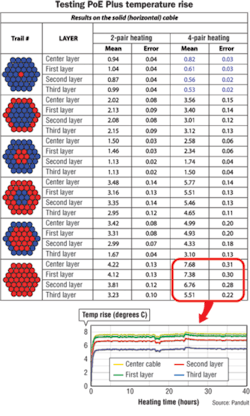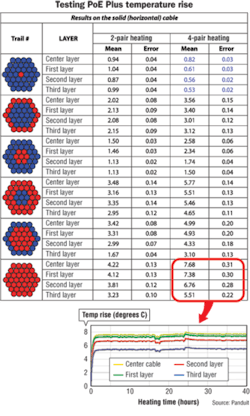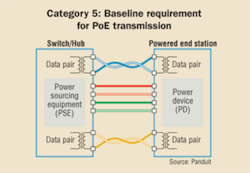by Michael Pula
As standardization efforts move ahead, questions about heat dissipation get answered.
Since the approval of the recommendations set forth by the Institute of Electrical and Electronics Engineers (IEEE; www.ieee.org) 802.3af task force in 2003, Power over Ethernet (PoE) equipment vendors have been designing standards-based products that leverage the numerous advantages offered by PoE.
To date, product deployments have included Voice over Internet Protocol (VoIP) phones, wireless access points (WAPs), IP network security cameras, and other devices capable of eliminating external power supplies in favor of accepting data and power via the Ethernet connection. Carrying the promises of scalability, ease of installation, and the flexibility to deploy PoE devices in hard-to-access locations, PoE has rapidly become a preferred technology for enterprise networks seeking speed of installation, cost savings, power management, and higher connection reliability.
As PoE equipment vendors begin to introduce enhanced products to feed the demands of organizations that desire greater functionality from their PoE devices, the power required to drive these new products is also on the rise. The IEEE 802.3af standard sets the transmission guidelines for PoE at 15.4 watts (and at least 12.9 watts per port at the endpoint). But new product introductions, such as cameras with motorized zoom and tilt capabilities, require more power to operate than the IEEE 802.3af standard allows. This need for more power resulted in the decision to begin work on a new standard.
In September 2005, the IEEE launched a task force to begin reviewing new PoE specifications to enhance the IEEE 802.3af guidelines into a next-generation standard, IEEE 802.3at-referred to as PoE Plus. The new standard seeks to increase available power delivery up to at least 30 watts (optionally up to 60 watts) to provide greater power for evolving applications.
IEEE 802.3at will be backward-compatible with all existing IEEE 802.3af devices, meaning that commonly deployed VoIP phones, WAPs, and IP network security cameras will operate on PoE Plus ports. While PoE Plus ports must be backward-compatible with standard PoE, new PoE Plus endpoint devices will be required to draw additional power over these ports.
As work progresses on IEEE 802.3at, questions have begun to circulate regarding compliance with the new standard and which infrastructure components may be necessary. Will current structured cabling be able to handle the increase in power? Are there additional considerations for heat rise in bundled cables?
How PoE Plus works
PoE, as defined by today’s IEEE 802.3af standard, supports 15.4 watts at the source distribution point via the power sourcing equipment (PSE), which can be PoE switches, PoE midspans, or PoE-enabled patch panels. The minimum supplied voltage must be 44 volts, with the current per twisted Ethernet pair calculated from the following:
Power = Volts ∙ Amps, or Amps = Power/Volts
The maximum required current per Ethernet pair is 15.4 watts/44 volts, or 0.35 amps (350 ma). To calculate power dissipated as heat in the Ethernet cable, we need to calculate the effect on each wire; so, 350 ma yields 175 ma (0.175 amps) per wire.
Power dissipated is calculated as follows:
Power dissipated = Amps2 ∙ Resistance
Assuming 10 Ω resistance per wire (worst case over 100 meters), the power dissipated per wire is calculated:
(0.175 amps) ∙ (0.175 amps) ∙ 10 Ω = 0.306 watts.
But because we have two wires per pair and use two pairs (send and return), we must calculate the total power dissipated for the Ethernet cable as:
0.306 ∙ 4, or 1.224 watts per cable.
Who’s concerned?
The IEEE formed the Data Terminal Equipment (DTE) Power Enhancements Task Force to enhance the existing 802.3af standard and to provide maximum power to endpoint devices within practical limits, including providing cable heating data for evaluation by the IEEE 802.3an (10GBase-T) working group.
The Telecommunications Industry Association (TIA; www.tiaonline.org) formed the Technical Recommendation (TR) 42 Premises Telecommunications Cabling Engineering Committee, which under the TR-42.7.2 Copper Cable working group is responsible for developing performance specifications, qualification procedures, and the test methods for copper twisted-pair cable.
The International Organization for Standardization (ISO; www.iso.org) and International Electrotechnical Commission (IEC; www.iec.org) under ISO/IEC JTC 1/SC 25/WG 3 committees are concerned with customer premises cabling, and specifically monitoring and setting parameters for radiated emissions, signal spectrum, and immunity on 10/100/1000 and 10GBase-T cabling.
Each of these committees and task forces cooperate with each other to advance cabling standards and recommendations for new services, such as PoE Plus over Ethernet cable.
Temperature’s importance
For PoE and PoE Plus, the condition to be monitored is the temperature rise above ambient room (or enclosure) temperature related to the cable or cable bundles transporting power. The following factors can affect temperature rise:
- Amount of current passing through the cable;
- Resistance per length of cable;
- Number of cables in the bundle carrying current;
- Powering carried on two or four pairs within these cables.
The IEEE 802.3ae task force has established a requirement for Category 5e, Category 6, and Category 6A cabling to ensure the resistance characteristics and the quality of transmissions. The TIA is recommending that the maximum heat rise be less than 10º C. This temperature rise will affect the cable performance slightly by increasing insertion loss by approximately 0.4 percent per degree of heat rise. A 10º C increase would require an approximate 0.35-dB greater performance margin or a shorter cable length.
Tests were performed for both two-pair powering and four-pair powering modes. (See figure, above.) Of significant interest is the ambient heat rise of approximately 7º C on the center cable in a fully powered 37-cable bundle. The performance tests indicate that even with all cables powered, ambient heat rise does not exceed the 10º C maximum established by the TIA TR-42 recommendation. Category 5e cabling is the lowest category as required by the IEEE 802.3at task force and performs well, as the test results indicate, when carrying power on all four pairs and all 37 cables in a bundle-the most strenuous of tests.
Looking to the future
PoE carrying 30 to 60 watts will be able to support significant new devices, ensuring infrastructure support for emerging technologies. New devices will also be released that consume less power, making the ubiquitous PoE port capable of connecting to a greater variety of devices. For example, laptop manufacturers, in an effort to reduce power consumption, may replace motorized disk drives with more efficient and less hungry memory arrays. Also, as light-emitting-diode (LED) display panels become more popular, the ability to increase the size and number of pixels (LED points) will be a function of the amount of sustained power available.
Mixed-mode installations of low- tomedium-powered devices combined with higher-power devices will balance the power required on customer premises cabling installations. These installations will certainly allow PoE and PoE Plus to be deployed across all ports in the LAN.
Michael Pula is product line manager at Paduit (www.panduit.com).
PoE standards
The telecommunications industry was built around 48-volt powering standards. IEEE 802.3af is the first international standard to define the transmission of Power over Ethernet (PoE); one recommended implementation for PoE is shown below.
This standard is based on existing Category 5 infrastructure as a baseline requirement to support voltage supply between 44 and 57 volts DC, 350 to 400 milliamperes, and 15.4 watts of power at the source. Category 5 and higher Ethernet cabling is capable of supporting these PoE devices up to 100 meters.
To achieve higher power for new endpoint devices, the power sourcing equipment (PSE) will be required to drive between 50 and 57 volts. For example, to deliver 42 watts to an endpoint device at 50 volts, the maximum current per Ethernet pair required is 0.840 amps (840 ma). The power dissipated can then be calculated as:
840ma/2 = 420 ma per wire, such that (0.420 amps) ∙ (0.420 amps) ∙ 10 Ω = 1.764 watts/wire, or (1.764 watts/wire) ∙ 4 wires, assuming 2-pair wiring = 7.056 wattsof power dissipated in the cable.-MP


